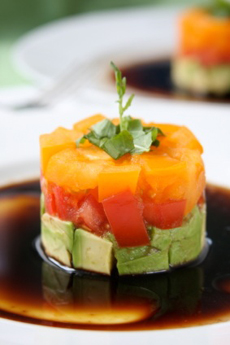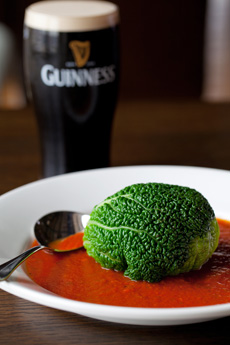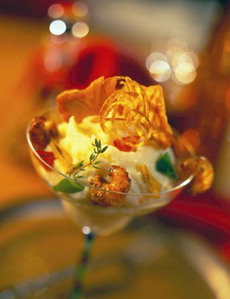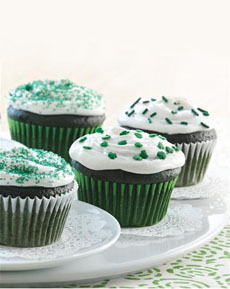|
Advice from the experts: Eat more salad. Additional advice from the experts: Don’t load up the salad with fattening dressings.
Here are 10 tips to make your salads so exciting, that a small amount of olive oil and negligible-calorie vinegar (or citrus juice) is all the dressing you need.
1. Mix Your Greens. If you’re budget-conscious, use a base of the more affordable iceberg and romaine lettuces, but blend in two other salad greens. Arugula, endive, radicchio, mache, red leaf lettuce, red cabbage, spinach and watercress are generally available, or you can buy a small amount of mesclun to toss with the iceberg or romaine.
2. Add “Secondary Greens.” Choose from broccoli, broccolini, broccoli rabe (rapini), cabbage, cucumber, fennel, green beans (raw or cooked), green olives, green peas, green onions (scallions), seaweed, snap peas, snow peas, zucchini and whatever we’ve left off this list.
|
|

Mixed baby lettuces including red leaf lettuce, plus radicchio, sautéed red bell pepper and pepitas (pumpkin seeds). Photo courtesy Bohemia Beer. |
|
3. Add Fruit. A few berries or grapes give natural sweetness and a color accent to any salad. But don’t overlook chopped dried fruit, diced melon or melon balls, figs, raisins, thin-sliced (matchsticks are great) apples and pears, and orange segments. Avocado is also a fruit.
4. Use At Least Three Colors. For red accents, consider beets, cherry or grape tomatoes (larger varieties in season), fruit, red onion, red bell pepper or jarred pimento. For the yellow/orange group, try carrots (for fun, shave them into ribbons), chickpeas, corn kernels or miniature corn, diced/sliced potatoes, shredded Cheddar, summer squash, yellow beets, yellow bell pepper or yellow tomatoes. For black accents, use black beans, black olives, black sesame seeds. For white accents: crumbled cheese, diced/sliced potatoes, cannellini beans, water chestnuts.
|

How creative can you get? This “salad” combines avocado, tomato and orange bell pepper with fresh herbs and a balsamic vinaigrette. Photo by Jan Infante | IST. |
|
5. Vary The Textures. Offset softer textures with some crunch (celery, Chinese noodles, croutons, fennel, iceberg lettuce, nuts, seeds, water chestnuts). Also add leftover cooked vegetables.
6. Add Leftover Proteins & Grains. Toss in a bit of beef or poultry, some cubed tofu, tuna or other fish or seafood, or sliced boiled egg. We’re not talking “dinner salad” but just small flavor accents. Also add any leftover grains or starches for flavor as well as texture.
7. Consider Some Cheese. A tablespoon of grated Parmesan, crumbled blue or goat cheese, or shredded semihard cheeses (Cheddar, Colby, Edam, Jack, provolone, ricotta salata and numerous others).
8. Think Themes. Try to come up with a different theme each week. For example, Asian-inspired salad with baby lettuces, bok choy, daikon and sesame seeds, and a rice wine vinegar/soy sauce vinaigrette; an Italian theme with radicchio, romaine, sundried tomatoes and shaved Parmesan; a Mexican theme with lettuce, black beans, green onions and a salsa dressing, topped with shredded queso blanco or Cheddar cheese.
|
9. Dress With Flavored Oils & Vinegars. Don’t be afraid of the “fat” from oil. Olive oil is a heart-healthy fat, and your body needs a tablespoon or two a day (the American Heart Association recommends two tablespoons). Spring for good vinegar; the bargain bottles can be acrid. And remember: white vinegar is for pickling, not for dressing.
10. Use fresh herbs. Some herbs make the salad sing: basil, chives, dill, parsley, sage and thyme, for starters. Snip it into the salad prior to tossing, or use as a garnish. If you like heat, add some diced fresh jalapeños (remove the seeds and ribs).
Now, we’re off to make a salad!
|
|








